Last attempt: Stalinogorsk assault
As Novomoskovsk ethnographer N. Chumichev noted back in the 1970s, “if Novomoskovsk’s labor achievement was marked by the Order of the Red Banner of Labor, then the military period of the city had not been studied for more than 30 years, and the residents were used to the fact that did not happen and in the underground no one was left. And this is fraught with great troubles in the upbringing of the younger generation. ”
This is what happened. Over the past 40 years, this statement has finally become the norm: Stalinogorsk passed without a fight. One-sidedly studied and covered only the liberation of the city, but not its defense. Modern veteran, public organizations of Novomoskovsk, the region and the region are not aware of the feat of the Siberians in their native land. A regular watch of memory in the Novomoskovsk region, military reconstruction of the defense of the city, a memorial sign to the Siberians of the 239 Infantry Division, or at least a memorial plaque? Maybe the merits of the division commander were awarded the title of honorary citizen of Novomoskovsk? .. And the city itself - the honorary title of "a military valor settlement"? .. No, they did not hear.
How did this happen? The already mentioned N. S. Chumichev names four reasons that have taken away military glory from the city. But there is also a fifth one: the majority of the townspeople inhabiting it do not have this business at all. “A man of restless heart”, Novomoskovsk ethnographer Chumichev, has long died, and now there are completely different trends in fashion ...
The recent scandal with the performance of the Urengoy boy in the German Bundestag clearly exposed this problem of modern Russian society. Alexander Saveliev, a search engine from Rybinsk, describes it very briefly:
Well ... although this is not a performance in the Bundestag, the word is to German veterans, thus the former fascists who stormed 23-25 in November on 1941 of Stalinogorsk. In many ways, you can disagree with them, but they certainly have nothing to fear for local patriotism and, especially, to embellish their opponent - the soldiers and commanders of the 239 Infantry Division in the battles of Stalinogorsk. So, a fragment of the combat history of the German 315 Infantry Regiment of the 167 Infantry Division, second half of November of the 1941 year: the assault and capture of Stalinogorsk (now Novomoskovsk) of the Tula Region. Comments of the translator in square brackets right in the text.
Franz Mayrhofer, Hrsg. Kameradschaft ehem. Gren.Rgt. 315: Geschichte des Grenadier-Regiment 315 der bayrischen 167. Inf.Div. - Almhütten-Division - 1939 — 1944, München 1975, 2. Auflage 1977. - S. 166 — 178.
Stalinogorsk assault 25 November 1941 of the year
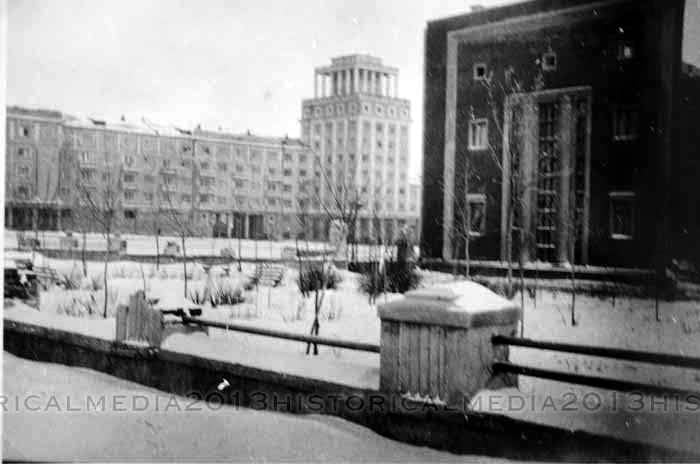
Stalinogorsk eyes of the German soldier
In general, the situation, apparently, did not look particularly rosy. The unloaded 17 of November, under the Nodal Part of the Siberian 239 th Infantry Division, with which the 53 Army Corps had fought since then, despite all the German plans, were still far from their defeat. On the contrary, the combat power of this Soviet elite unit has repeatedly caused serious harm. And also nothing foreshadowed the fact that they could be so quickly disposed of. Guderian described the following events as follows:
“November 26 The 53 Army Corps approached the Don, forced it with the forces of the 167 Infantry Division near Ivan-Ozer and attacked the Siberians northeast of this settlement, near Don. The valiant division seized 42 guns, a number of cars and up to 4000 prisoners. From the east, the 29-i motodivision of the 47-second tank corps was advancing on the Siberians, as a result of which the enemy was able to be surrounded. ”
This is to a certain extent a concise account of events in Guderian’s memoirs. Since the 315 Infantry Regiment took an exceptional part in these events and contributed significantly to its success with its military operations, it seems necessary to go deeper into the details of what happened.
The environment of the adversary in front of the 53 Army Corps began on November 25 of the year 1941 [inaccurate: already 24 November, units of the 29 motorized infantry division cut the rear communications of the 239 th rifle division in the east].
In its rear in the east were parts of the 29th motorized infantry division, in the north it struck further than the 47th tank corps [Already on November 24, the mechanized infantry units of the 4 Tank Division, supported by the tank group of the 3 Tank Division of the 47 Tank Corps, took up positions in the north at the site of the alleged Siberian breakthrough]. In the south, in particular, in the south-west, the 53 Army Corps is located in front of the Urvanka-Klin-Donskoy border held by the enemy: the left wing, by the 167 Infantry Division, in front of the Urvanka-Klin border, and on the right, the 112-Infantry Division in front Don. In the meantime, while the exhausted 112 Infantry Division had to maintain its position, the 167 Infantry Division should continue its attack on Urvanka, seize the Urvanka – Ivan-Ozero line on the Don, and after reaching the Don River to the west from here, turn south to finally surround the enemy, who is in front of the front of the 112 Infantry Division, if he retreats earlier.
The 315 Infantry Regiment, reinforced by the 1 Battalion of the 238 Artillery Regiment and assault guns, was assigned the combat task of advancing to the right of the Kamenka-Urvanka road, knocking down the enemy in Klin; on the left, the reinforced 339 Infantry Regiment should attack. Then, after the capture of Urvanka, both regiments must first break through in the direction of Ivan-Ozer to the Don River.
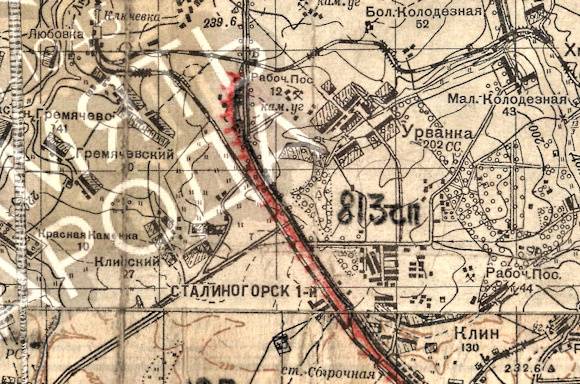
The line of defense of the 813 Infantry Regiment of the 239 Infantry Division along the railway embankment to the west of Urvanka and Klin. Fragment of the Soviet military reporting map of the 50 Army on November 23 of 1941. TsAMO.
The plan was made well, but will it be possible to implement it? At the headquarters of the division doubted.
“According to the [headquarters] of the division, there are too few available forces to accomplish this task, since the enemy is outnumbered by us and, moreover, defended very skillfully in a long industrial area [Speech about mines and factories between Urvanka and Donskoy]. When you try to clean up the area, the enemy’s superiority in numbers will appear even more clearly. ”
- This is what the 167 Infantry Division’s 25 Combat Warfare Journal says for November 1941 of the year. In fact, the fears were justified, especially with regard to the planned breakout area. Before the front of the 167 Infantry Division, a whole industrial area and urban development stretched from one of the settlements west of the Don River: in the south of Urvanka, immediately to the northeast of Ivan-Ozero, then in the north - Stalinogorsk [more precisely: Stalinogorsk-2; the southern Stalinogorsk-1 between Urvanka and Klin was not generally marked on the maps of the 167 Infantry Division]. Silhouettes of new high-rise buildings and factory chimneys, between which, like lost, miserable quarters with wooden huts as remnants of former rural settlements, their invisibility was exceptionally suitable for defense.
[The command of the surrounded Soviet 239 th rifle division was also well aware that its rear communications in the east were cut by the German 29 th motorized infantry division, and the way north to Silver Ponds is closed by the 4 th tank division. Therefore, in the evening of November 24, an important decision was made to break to the east. On the night from 24 to 25 in November, the 239-Infantry Division began an organized departure to the east, leaving behind cover units. The fighters and commanders of these detachments were to take an unequal battle in order to detain the German troops as much as possible and to enable the main forces of the division to break away. And before that, they themselves still had to attack - it was impossible to let the enemy know that they were planning to withdraw.]
But what remained - the order must be carried out. The attack should start at 8: 00 [Berlin time]. But, as if they knew about it, the Russians had already attacked before. In 5: 15, long before the cloudy daylight of November 25, the Siberians, turning into rifle chains, rolled over to the position of the 167 Infantry Division, lay down under barrage and rushed forward again. This lasted for about an hour, then the Soviet soldiers surrendered - all their attacks were repelled.
Already 6: 30. The best thing would be to immediately go to the counterattack, while the Red Army soldiers did not organize the defense, and their attacking units were in disarray because of the withdrawal. But there this damned railway embankment was located southwest of Urvanka, which for several days was well known to the infantry of the 315 Infantry Regiment. Behind her, the Russians equipped in several rows well-disguised machine gun firing points and positions of anti-tank guns that controlled the field in front of them. Therefore, at first it was necessary to wait for the combat readiness to open fire of their own heavy weapons. Soon this time has come.
105-mm field howitzers of the 1 division of the 238 artillery regiment were thrashed, mines with a roar flew over the heads of the infantrymen and whined at the railway embankment. The salvos perfectly fit the target. Despite this, the attack was not an easy walk. Because in front of the railway embankment, which was located, as if protecting the town of Urvanka, there was a level field without any possibility of shelter. Soviet guns fired from the embankment of direct fire on the attackers.
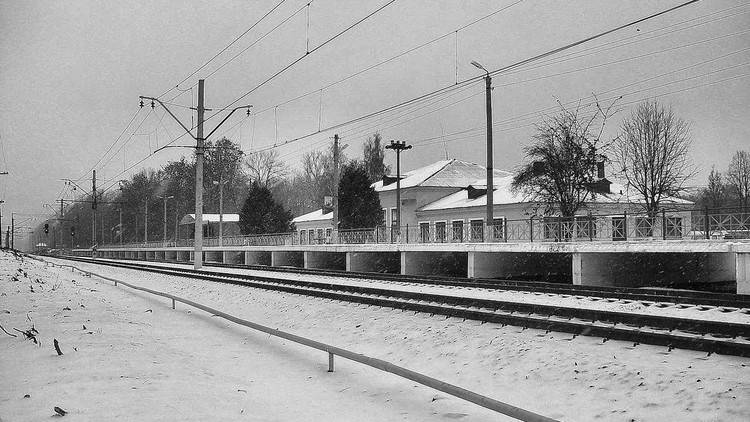
"This damned railway mound" is now part of the Novomoskovsk railway ring.
A view of the Novomoskovsk-1 station of the Moscow Railway from the west, from where the German 167-Infantry Division was advancing from Uzlovaya (Kamenka) to the position of defenders of Stalinogorsk.
Photo: Delta7 / Novomoskovsk Railway, December 2009.
From high-rise buildings [obviously, urban building Stalinogorsk-1] Towards the infantrymen of the 2 and 3 battalions, they were beaten by the slow lines of “so-and-so” Russian Maxim machine guns - their firing points could not be immediately detected in the endless window openings. In addition, the flanking fire (especially artillery) from the southeast from the Klina region became quite tangible.
Despite this, the 315 infantrymen coped. 5-i company under the command of Chief Lieutenant Kopske [it. Kopske] and 8-I company of Chief Lieutenant Roskoten [German Roßkothen] with the active support of assault guns of the [202 Division of assault guns] near 8: 45 reached the railway embankment and jumped over it to the other side.
Siberians defended to the last, preferring to be killed, but not to leave their solitary trenches, shelters. Captain Mayerhofer [him. Maierhofer] consulted for cover with Chief Lieutenant Roskoten, Chief Lieutenant Kopsk and platoon commander Feldwebel Edenhofer [him. Edenhofer]:
[Captain Franz Mayerhofer, him. Franz Maierhofer (Mayrhofer), Commander of the 2 Battalion, 315 Infantry Regiment, 167 Infantry Division. Participant in the assault of Stalinogorsk-1, holder of the military order of the German Cross in gold (July 1 1942). Author of this combat history of the German 315 Infantry Regiment.]
Feldwebel Edenhofer with her platoon should smoke the machine gun nests on the left, with him the 5-i company. The 8 Company must move to the right. Farther! Russians don’t give up, screaming out queues from machine-gun nests. Feldwebel Edenhofer barely lay down in the shelter, when behind him he saw his approached company commander, who ran straight into the zone of destruction of one machine gun. Feldwebel instantly saw the danger and shouted:
“But it was too late.” Chief Lieutenant Kopske collapsed in 5 meters behind Edenhofer and died shortly thereafter. A little later, death caught up with Chief Lieutenant Roskoten, when he wanted to approach directly to one Russian in order to capture him. The Red Armyman threw his high weapon, the shot wounded the chief lieutenant so badly that he died a few hours later at the divisional medical center.
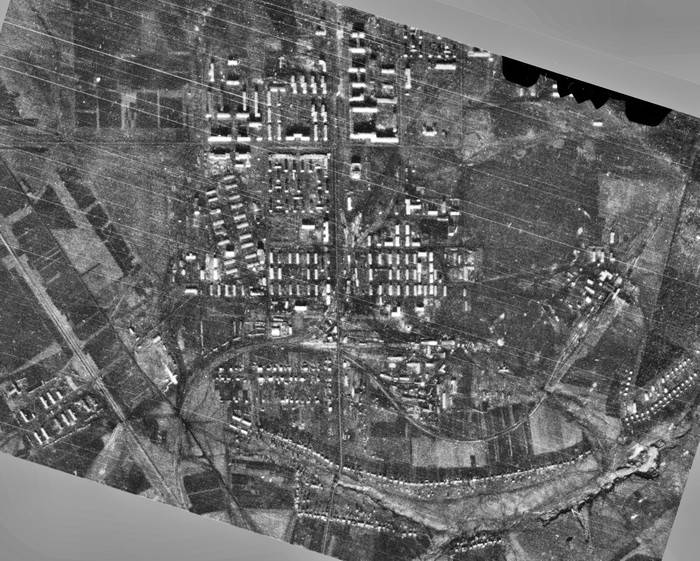
Here, between Urvanka and Klin, "only the fierce resistance of the Russians grew stronger."
German aerial photography of Stalinogorsk-1, November 1941 of the year.
Now fierce hand-to-hand fighting was raging everywhere, infantrymen of the 2 and 3 battalions at the outskirts of the settlement of Urvanka made their way through, meter by meter. Because of the enemy, who sat down in well-equipped positions, the losses increased constantly.
At least, now also managed to advance the right wing of the 315 Infantry Regiment. There, the precise fire of the 1 Division of the 40 Artillery Regiment and the 1 Division of the 238 Artillery Regiment according to Klin weakened the enemy so much that the 1 Battalion of the 315 Infantry Regiment in 10: paragraph. In 15: 12, the defense in Klin was broken through and reached the railway embankment to the north-east of it.
At the same time, on the left flank in front of the 2 and 3 battalions, the fierce resistance of the Russians strengthened. Both battalions, along with the right wing of the 339 Infantry Regiment, broke into the settlement of [Urbanka] and fought a hard street fight. The left wing of the 339 Infantry Regiment near 14: 00 reflected a strong counterattack of the [239 Infantry Division] from the northeast direction. Throughout the second half of the day, the battle in the industrial area of Urvanka was going on with the utmost bitterness. Slowly, taking possession of the house behind the house, the 315 Infantry Regiment advanced. Hand grenades flew into the houses, expelling the Russians entrenched in them. In some places, the Soviet [troops] were defeated in the hardest melee, hand-to-hand. Right up to the night, machine guns knocked, carbines sounded and hand grenades rumbled. Then finally there was silence.
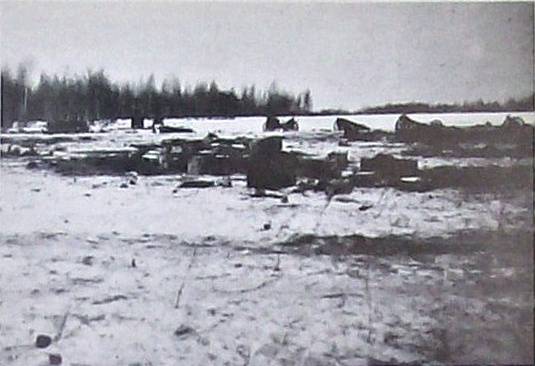
Late November 1941: destroyed enemy fortifications at Stalinogorsk.
In 20: Urnanka's 00 was taken — this is an outstanding achievement of heavily weakened regiments, about which the division commander personally congratulated the commanders of the 315 and 339 regiments by telephone. But success was also bought at a rather expensive price: the 315 Infantry Regiment alone reported as current losses on the 100 injured and on the disposal of the 5 company commanders. The 2 Battalion was especially badly damaged, because of the killed Ober-lieutenants Roskoten and Kopsk who died in battle, he lost two extremely capable and courageous company commanders. The 3 Battalion, which was also badly damaged, was taken back to Kamenka in the evening.
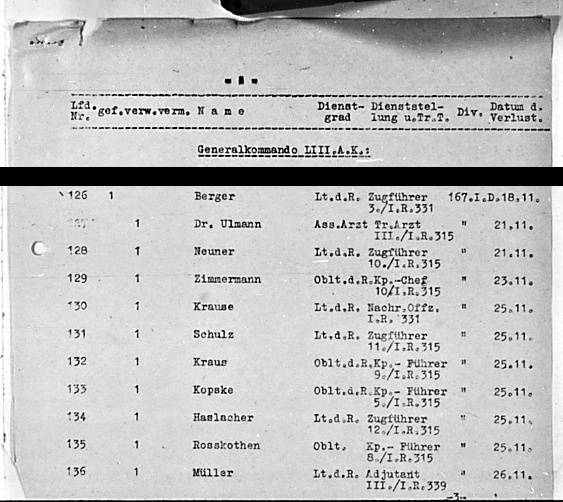
Fragment of the list of casualties of officers of the German 167 Infantry Division of the 2 Panzer Army in battles with the Soviet 239 Infantry Division 21-26 in November 1941 of the Year (NARA).
The description of this battle cannot be completed without paying tribute to the outstanding achievements of the military doctors and their orderlies participating in it. The battalion doctors, Dr. Aman [German: Amann] and Ulman [German: Ullmann] personally helped to carry the wounded out of enemy fire and, like the regimental doctor Dr. Kreuzer [German: Kreuzer], provided medical assistance non-stop and in difficult conditions people with sometimes severe injuries. For many of them, this selfless activity has saved a life. Both Dr. Aman and Dr. Ulman for their proven courage in front of the enemy received an iron cross of the 1 class.
Cleaning the area in German
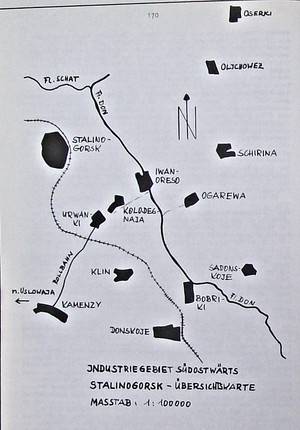
On 26 in November, the order for division No. 116 defined the following boundaries of hostilities:
“1) The enemy — at least one division — is surrounded by the 167 th Infantry, 4 Tank Infantry, 29 Motorized Infantry and 112 Infantry Divisions in the area of Dons-Klin-Kolodeznoye-Shirino-Ivankovo.
2) ... The 167 Infantry Division slams the encirclement ring from the west and north and squeezes it, sweeping the industrial area and the forest massif south and southeast of Urvanka ... "
[The mentioned “at least one division” is the Soviet 239-Rifle Division, together with volunteer girls from the local residents of Donskoy and Stalinogorsk who joined it. “The forest massif to the south and south-east of Urvanka” is also better known as the Urvansky forest, in which the central park of culture and recreation is located, and the mass grave of those who died during the defense of Stalinogorsk.]
To fulfill this order, the 331 Infantry Regiment without its 1 and 3 Battalions, with the subordinate 3 Battalion of the 315 Infantry Regiment, had to be alerted to attack the division from Kamenka to the east and capture first area between station Donskaya and Klin (excluding this settlement). The purpose of this maneuver was to prevent the breakthrough of a surrounded enemy, facing the front of the 112 Infantry Division.
The reinforced 315 Infantry Regiment (without the 3 Battalion) now received a combat mission together with its subordinate 3 Battalion of the 339 Infantry Regiment, according to the original plan, to advance from Urvanka in the southern and southeast direction, clean up the industrial area and forest area to the south and southeast of Urvanka and break through to the Klin line - 2,5 km northeast of Klin. Then at this turn the regiment should prevent the enemy from breaking to the north. The right wing must establish and maintain communications from Klin South with the left wing of the 331 Infantry Regiment, that is, the 3 Battalion of the 315 Infantry Regiment. The assault guns — finally, the new arrivals — remain under the control of the 315 Infantry Regiment.
Scheduled maneuvers went according to plan. The enemy did not offer significant resistance; with the exception of scattered parts, he must have moved from the west bank of the Don to the east. During the day, the forest area to the south and south-east of Urvanka was cleared up to Klin, the 3 battalion to the east of Kamenka reached its goals for that day in the factory area of Bobriki-Donskoy.
[Hasn't German intelligence figured out that there were no Soviet troops in this area? The main forces of the 239 Rifle Division had moved eastward on the night from 24 to 25 in November, leaving strong cover groups at this turn, which took the fight to 25 in November.]
As a result, the 167 Infantry Division was located between Urvanka — Stalinogorsk (in the north) and Donskoy — Bobrika — Klin (in the south) on the entire west bank of the Don; By evening, the military guard had already been set up near the two bridges across the Don near Ivan-Ozer to the east.
Nevertheless, the division’s combat readiness has declined significantly due to heavy losses in recent days and lack of rest. The infantrymen were waiting for the moment when finally they would be left alone, at least for a while; they were exhausted and dead tired - in short, fully prepared. The division headquarters also expected a respite and expected that the 29 motorized division from the east and parts of the 4 tank division from the north should now compress the encirclement ring. In the end, the main burden of the fighting fell on the 167 Infantry Division. But again, everything happens quite differently.
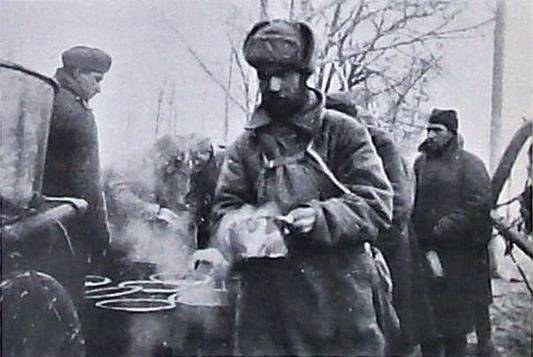
Russian prisoners for food.
Backstab Siberians
In the evening of November 26, 1941, at the command post of the 167 Infantry Division in Nodal, after the turbulent day hours, it also became quiet. In the dim light of the gasoline oil lamp, the coherent messengers tiredly nodded, nothing more urgent was there. In 23: 20 rattled the field telephone. Urgent conversation with the headquarters of the [53 Army] Corps! Captain Behnke [German: Boehnke], who took over the duties of the head of the operations department of the 167 Infantry Division. At the other end, the head of the operational department of the corps, colonel of the general staff Veger, introduced himself. Waeger]:
"Now this, too ..." thought Captain Behnke. “Right now, when people were hoping for a fully deserved rest!” Then he woke the division commander. Slowly, both of them above the unfolded map evaluated the situation, how can the hull task be accomplished.
Both officers quickly finished with their assessment of the situation: to execute an order to prosecute the enemy, there is only one 339 infantry regiment exhausted by battles, since according to temporal and spatial calculations both 331 and 315 infantry regiments could only go too late to the opponent from their current positions. But could the 339 Infantry Regiment in its current state be capable of this new effort with the expectation of success?
In order to clarify this, a telephone conversation between the division commander and the commander of the 23 Infantry Regiment [Major Grosser] took place on 45: 339. Major Grosser could say little that was good: the difficulties would be extremely great - now, after the order was already issued on 27 November to hold the current boundaries. In addition, completely exhausted people can hardly be moved forward. At night, they have even less rest than during the day, because people cannot follow each other in companies that have 35 left, because every person is involved.
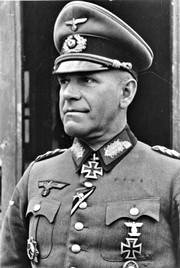
Under such circumstances, Major General Trirenberg [him: Trierenberg] agrees with his chief of operations, that the order given can hardly be executed. This position should be immediately reported to the corps headquarters.
[Major General Wolf-Günther Trirenberg (Ger. Wolf-Günther Trierenberg; 18 June 1891 - 25 July 1981) - from 11 August 1941, commanded the 167 Infantry Division. 10 May 1943 was awarded the Knight's Cross of the Iron Cross, the supreme order of the Third Reich, for the skilful leadership of the division.
Major Justus Behnke (Justus Boehnke) - Head of Operations of the 167 Infantry Division from December 15 1941. In the period of the battles of Stalinogorsk he served as the head of the operations department.
Kurt Weger (German Kurt Waeger; February 6 1893 - June 18 1952) - Chief of Operations Division of the 53 Army Corps, Colonel of the General Staff.]
In 0: 10 [27 in November 1941, the Chief of Operations] captain Bencke calls the corps headquarters, and he connects with Colonel General Staff Weger. Captain Behnke: “Despite the fact that solutions have already been found in many difficult situations, in this case the solution has not yet been found, since it is almost impossible to overcome difficulties with exhausted parts in accordance with the allotted time and terrain specificity.”
To which Colonel Weger responds: "The divisions are allowed to use the bridge at Bobriki before the 112 Infantry Division."
“This is a complete underestimation of the real situation,” Benke said in his head. Which bridge is the most insignificant obstacle in the way of a throw to the northeast. And he objected: "Despite this, the troops will not be able to launch an attack before dawn, since the artillery will have to be advanced into positions along undiscovered paths."
Up to this point, with growing irritation, the conversation was listened to [by the commander of the 167 Infantry Division], Major General Trierenberg. Now he grabbed the headphones from his chief of operations and continued the conversation himself: “You can give an order to follow the instructions, but if people can cope and if they can speak, I don’t know, but we will irrevocably destroy our troops.”
There was silence for a while, then came the answer from Colonel Weger: “Yes, we have to try, and if people say that you can grab cannons as a trophy ...”
The division commander did not hold back his indignation: “It’s all the same to the soldiers, they want to get some sleep in the end ...” But Major General Trierenberg could not help his anger either. An order is an order; as part of the overall situation will have to demand from the personnel the impossible.
The division order No. 117 of November 27 of 1941 of the year defined:
"1) According to the intercepted order of the [Soviet 50 th] army, an enemy of an unspecified number of November 27 breaks out from the Spasskoye-Olkhovets area through Ozerki to the north ...
2) The 167 Infantry Division is to strike on November 27 with all available forces from the Ivan-Ozero area in the direction of Ozerka from behind at this enemy in order to carry out its final destruction ...
3) For this, the 315 Infantry Regiment with its reinforced battalion captures Shirino and neutralizes a possible threat from the enemy to the right flank of the 339 Infantry Regiment. At least one company of another battalion should be advanced to cover east to Ogarevo.
Ogarevo should be reached no later than 10: 00, Width - no later than 11: 00 - if possible, as early as possible. The rest of the regiment keeps the defense on the Don in the same area ... "
In the first echelon of the 315 Infantry Regiment, the 1 Battalion marched, attacking first; The 2 and 3 battalions of the 315 November Infantry Regiment 27 remained in their defensive positions.
The attack develops rapidly. Around 14: 00 The 331 Infantry Regiment occupied Olkhovets, and already in 15: 25 the enemy before the 167 Infantry Division in the Spasskoe-Olkhovets area was stopped after the initial resistance and was captured or destroyed.
The units of the 315 Infantry Regiment, which took part in the fighting and advanced beyond the Don, reached the Kozhanka-Ogaryo-Shirino-Trosnikovo area (2 km east of Shirino), the regiment command post in Ogaryovo.
Numerous prisoners and extensive trophies are the result of today: 10-12 batteries of all calibres, 15-20 light and medium tanks, several anti-tank guns, rifle weapons, light and heavy machine guns, 30 field kitchens, many rented cars and other military equipment.
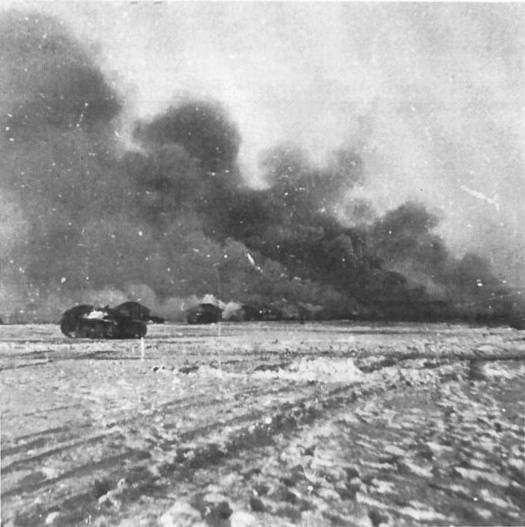
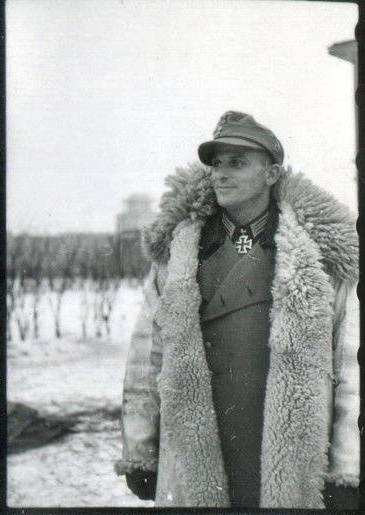
1) Set on fire the Russian village. Supposedly, the burning village of Spasskoye, or the village of Olkhovets (now in the city of Novomoskovsk as a part of the municipality), after the fighting with the 239 Infantry Division, 26-28, 1941 breaking through from the environment.
2) The commander of the 7 Company of the 2 Battalion of the 331 Infantry Regiment of the 167 Infantry Division, Lieutenant Gerhard Mokros 27 November 1941 of the year at the photo session in Stalinogorsk-1. In the background - the house "under the tower" in the center of Stalinogorsk.
Absolutely impossible, but incomplete victory at Stalinogorsk
"The impossible was impossible for the troops to do their utmost and were rewarded for their endless tensions with a result that can be justly proud of," as the 167 Infantry Division noted in the combat magazine. The commander of the 53 Army Corps noted the result achieved in the following order of Corps No. 69 from 28 in November 1941 of the year:
"Soldiers of the 167 Infantry Division!" Once again, the brave 167 Infantry Division attached the victory to their banners. In the snow and frost with extraordinary efforts and sacrifices, she heroically knocked the surrounded enemy from its fortifications. After the warm victory at Stalinogorsk! In addition to numerous prisoners, only 44 guns and about 20 tanks were in our hands. Gratitude and gratitude to you, your brave soldiers, who got a new victory of the 53 Army Corps in battle. Greater joy and you could not deliver your radiant commander. Forward to the final victory! Weisenberger.
These words of appreciation are fully true. Marines literally squeezed out of themselves the last to achieve complete victory. But still, despite their sacrifices, the victory was incomplete, since the main forces of the surrounded Siberian 239 Infantry Division could, even if leaving all their tools and vehicles, escape to the east. The units of the 29 Motorized Infantry Division there were numerically just too weak to prevent this. Excellently equipped, with white fur lined camouflage suits and even with a white-coated weapon, already at night on November 27, the Siberians again also suddenly attacked a few environmental forces, destroyed everything and eventually fought their way east between the 2 71 battalion Infantry Regiment and 1 Battalion 15 Infantry Regiment. Both battalions of the 29 Motorized Infantry Division suffered heavy casualties.
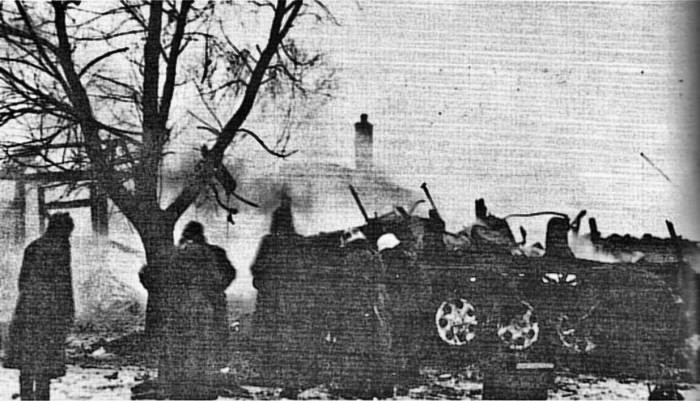
The burnt down equipment of the German 29 motorized infantry division in the village of Novo-Yakovlevka after the night battle of 27 November 1941 of the year, during which the main forces of the Soviet 239 rifle division broke from the ring of encirclement under Stalinogorsk and went east to Pronsk (Ryazan region).
Guderian himself simply could not understand how this could happen. At first, he believed that the cause of the failure was negligence in the conduct of reconnaissance and combat protection, and in order to clarify, 27 November personally went to the location of the most affected 71 infantry regiment. However, from reports on the spot, he quickly realized that the troops had fulfilled their duty and were destroyed only because of their numerical superiority. Even more than words, this was confirmed by the numerous bodies lying in the snow in a protective uniform, still clutching their weapons in their frozen hands.
Major-General Trierenberg and his chief of operations were right, as they warned in a night telephone conversation with the headquarters of the [53 Army] Corps, that the 167 Infantry Division would come too late ...
[...]
28 and 29 November The 315 Infantry Regiment was still in the reached area of Ogaryovo-Shirino, combing the area in search of scattered Russians, as well as trophies, to ensure their safety and take under protection.
The advance to Venev began on November 30 of the year 1941. After passing through Olkhovets, the 315 th infantry regiment reached the area of the village of Belkolodez, where the regiment command post and the 3 battalion were located. The 1 Battalion will stop east of here at Vyselky, the 2 Battalion will continue north to Savino. On the march through the village of Olkhovets, the infantrymen presented an impressive picture of destruction. In complete disorder, partly burned and destroyed by the explosions were hundreds of Russian trucks, many tanks, tractors and guns left by the Siberian 239 th infantry division at the breakthrough. And as before, under similar circumstances, the infantrymen asked themselves how, with such terrible losses in men and equipment, the Russians always again manage to throw new forces against the advancing German forces. Is this country really inexhaustible?
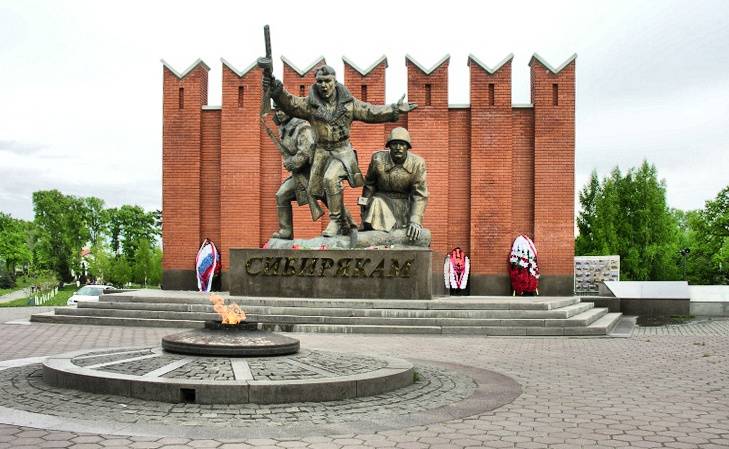
Memorial complex "Siberian Warriors" in Novomoskovsk ... no.
In the Lenin-Snegiryovsky Military History Museum, pos. Snegiri Istrinsky district of Moscow region.
- F. Mayerhofer, trans. with him. A.E. Yakovlev, "Stalinogorsk 1941"
- https://stalinogorsk.ru/poslednjaja_popytka_2
Information